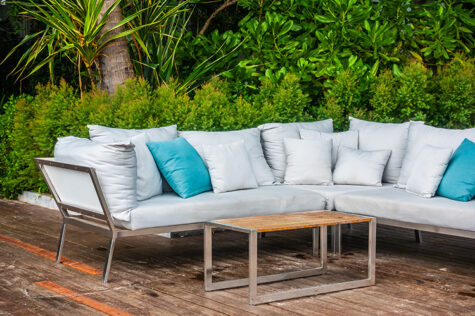Ever wondered how to make garden furniture from railway sleepers? The possibilities are endless when it comes to what you can create with wooden sleepers. Everything from a simple table, a bench or even a stunning walkway is possible. Railway sleepers are made from incredibly durable wood that will add a special flair to your garden.
Did your imagination just take flight? Let’s make your dream a reality.

Rustic furniture made from railway sleepers is incredibly sturdy. Credit: Shutterstock
How to make a railway sleeper bench/coffee table
This is one of the easier projects involving railway sleepers. Let’s get you started.
Supplies and tools
Before you get yourself too hyped up to think, remember you’ll need some supplies and tools to make your dream a reality. Here is a list of the tools and other materials you’ll need:
- Railway sleepers (you can buy railway sleepers online or purchase them from wood merchants.)
- A drill and long drill bits
- Spade drill bit
- Auger drill bit
- Handsaw
- Hammer/wooden mallet
- Measuring tape
- Wood glue
- Brush
- Wood preservative or stain
- Dowels
- Sander and sandpaper
- Hex drive timber screws
- Circular saw
- Crows foot triangle
- Safety gear
- Pencil/chalk
Method
Building railway sleeper furniture is fairly simple but you need to be careful. The machinery required can be dangerous and railway sleepers are very heavy. Make sure to acquire the appropriate safety equipment beforehand and take precautions when using the tools required for this project.
Step 1: Safety
As mentioned, safety should be your top priority. Make sure to put on your safety glasses, gloves, mask and any other required safety equipment like steel-tipped boots. Take care when working with the machinery and turn off or unplug it when not in use.
Step 2: Measure the railway sleepers
You most likely have long uncut railway sleepers to work with. To make your design a reality, you’ll have to do some measuring and planning.
Measure out the sections you want by starting with the seat/surface area. This area will be a bit longer than the rest of the structure. You could even use the whole railway sleeper if you’re going for a long sleek design.
The length of the legs will depend on the kind of railway sleeper you have. If it’s the square variety, you’ll have to take into account the width of the surface area, if you have the one that resembles a plank, you’ll have to add railway sleepers on top of each other to get the height right. To make it simple, measure the width of the railway sleeper you’re working with and add length to it until the total measurement is around 40 cm (16 inches) high.
Coffee tables have a standard height of around 40 – 45 cm (16-18 inches). This is also the perfect height to sit on if you want to use it as a bench instead.
Make sure all 4 sides are marked once you’ve finished the measuring.
Step 3: Cut the wood
Now that you have all your measurements, you can start with preparing your railway sleepers. For this part, you’ll need a handsaw, circular saw and of course the marked railway sleepers.
Start by checking if the ends of the sleepers are square. If not, you’ll have to modify them slightly to fix this problem. Remember to remove any staples at the ends before you start. If there is a problem, you can correct it by either using the circular saw to remove the excess wood and make the ends square or you can sand it until the excess has been removed. Double-check your previous measurements to make sure everything is still in order on the modified sleeper.
For cutting your measured lengths, you will need to start with the circular saw. Place the railway sleeper on your workbench or another solid surface to work on. Put on all your protective gear and get the saw ready. Once you’re ready, take the saw and follow the lines you’ve drawn to cut the wood. If the circular saw doesn’t cut all the way through, you might have to use the handsaw to finish the job.
If you’re worried that the line won’t be straight, you can use another plank or object with a perfectly flat edge to act as a guide. You will also need to turn the railway sleeper since the saw won’t be reaching all the way through.

Take great care when sawing your railway sleepers. Credit: @the_scaffold_furniture_co
Step 4: Sand everything down
The best time for sanding is before assembly. This will allow you to nicely round off all the edges and create a beautifully smooth surface. You will need the sander and sandpaper for this job. Make sure to use sandpaper with a fine grid to avoid creating ugly lines on the wood.
Using a sander will make the job much faster than doing it by hand. Make sure to use safety glasses and a mask for this part of the project. The fine dust particles can cause serious problems if inhaled. Also, make sure the room is well ventilated if sanding indoors.
Step 5: Assemble the table/bench
Line up your table legs and place the two or three railway sleepers that will make up the seat/tabletop on top of the legs. Before you start to secure anything, move the legs into position. Measure the distance from the edge to the leg to make sure both sides are the same.
Once you are sure, you can place some wood glue on the areas where the leg attaches to the top railway sleepers. Again make sure everything is perfectly lined up. To keep everything stable in place, you can put in a long hex screw.
The screws will help to hold everything in place while you prepare the railway sleepers to be secured by the dowels.
To place the screws, drill a small pilot hole. The head of the screw should not be visible above the rim of the hole and also leave some space for a filling that will come later on. Once ready, secure everything together with the screws inside the pilot holes you just created.
Step 6: Secure the dowels in place
You will need the spade drill bit to create the pilot holes for the auger drill bit. To make everything look neat, place the dowel holes an equal amount of space from the edges of the wood on both legs.
You can use your pencil and crows foot to draw a diagram to help you to line up where they need to go. Start by finding the centre of the leg and draw a grid line over the top to tell you where it is. Once done, you can find the centre of each individual railway sleeper that makes up the tabletop and draw a cross over your previous line. You should now have a + sign everywhere you need to drill a pilate hole. Do the same on the other side.
Before drilling, make sure to start in the centre of the plus sign where the lines cross. Drill until you’ve drilled through the top railway sleeper into the one functioning as a leg. You can now either switch drill bits or continue on to the next cross. If you continue on, drill all the pilot holes before switching your spade bit for the auger bit.
Make sure your auger bit is the perfect size by holding it up next to the dowels you intend to use. The bit and dowel should be very close in size with the bit just very slightly bigger to create a tight fit.
Line up the auger with the pilot holes and start drilling. Before you do them all, however, secure one dowel in place to make sure the fit is correct. If you haven’t cut your dowels to the correct length yet, now is the time to do it.
Measure your dowels longer than what you actually require. This will allow you some length to work with when hammering them in place. Cut the dowels either with the circular saw or hand saw, whichever you’re more confidant working with.
Now you’ll need the sander again to gently taper off the edges of the dowels. Don’t throw away any scrap pieces since you’ll be using those to hide the hex screws later.
Hammer your first dowel in place to make sure the fit is tight enough. If it works, continue drilling the rest of the holes for the remaining dowels.
If you don’t want to damage your wood while hammering the dowel in place, either use a wooden mallet or an offcut and a metal hammer. The offcut will protect the wood underneath from getting damaged by the metal hammer.
Use your method of choice and hammer all the dowels in place. You can put a bit of glue in the hole to make it extra secure.
Once all the dowels are hammered in, you’ll be left with a piece sticking out. You can remove this piece by simply sawing it off with the handsaw. Repeat this action until all the dowels have been shortened.
With the leftover pieces, you can now plug the holes you created for the hex screws to hide them. You might need to make the pieces a bit smaller by sanding them down. If there are some sticking out, cut them again as you did for the dowels. You can also add glue to secure everything in place.
Plug screw holes with dowels for the perfect finish. Credit: @refurb.creations
Step 7: Create a smooth finish
The next step is to create a smooth finish to make your creation look stunning. Grab your sander with some sandpaper and start to sand the areas you just worked on until the area looks seamless and feels smooth.
Use a brush and make sure to brush all the dust away. When you’re ready, get your wood sealant or stain and start painting your new creation. Let the layer dry completely between applying coats. You will need at least two or three coats to create a stunning finish.
Now all that’s left to do is move your bench/table where you want it and you’re done!

Take care to sand away any splinters before using your furniture. Credit: @shoplandsawmills
FAQs
Can I use railway sleepers in my garden?
Definitely, as long as the railway sleepers were treated with environmentally friendly, non-creosote preservatives such as ACQ and Tenalith E.
Do garden sleepers need to be treated?
Railway sleepers can last for many years, even decades without being treated. This is especially true for reclaimed railway sleepers. If you like, you can add an extra layer of protection against sun and weather damage by applying a wood preservative.
Which sleepers last the longest?
Hardwood railway sleepers made from oak are the most durable. They tend to have an expected lifespan of around 100 years even if left untreated.
In comparison, untreated softwood will last around 3 to 5 years and treated softwood around 30 years if maintained correctly.

Save this pin for later






